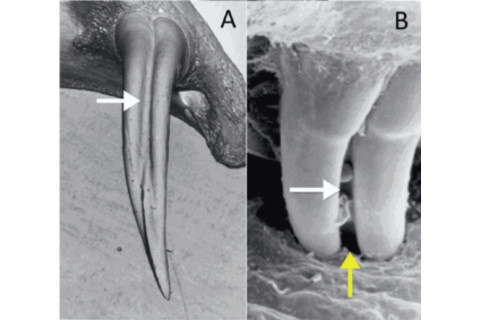Most poisonous snakes don't inject their prey with venom; instead, they bite the prey and venom insidiously trickles down a groove on their fangs into the wound. A new study in Physical Review Letters investigated the physics behind how venom travels down the grooves: It turns out that snake venom has unusual viscosity properties that keep it cohering together until it's time to flow down the fangs and into the snake's soon-to-be-snack---the same properties that account for how ketchup seems stuck in the bottle, then flows freely onto your fries. How the Heck:

What's the News:
The researchers found that snake venom, like ketchup, is a non-Newtonian fluid, meaning that its viscosity depends on how fast it's moving. Before the snake's fangs make contact, the venom sticks together pretty well, rather than coming down the tooth in a constant trickle. Once the fangs sink in, however, and the venom starts dripping down the groove, it flows freely.
What starts the venom flowing, the study suggests, is that when a snake bites down on its prey, the groove forms a tube that produces suction, helping to pull the venom into the wound.
In addition, snake venom has high surface tension, which helps it stay in the groove as it flows down the snake's fang.
What's the Context:
This venom-delivery strategy is common among not only snakes but other reptiles, too; it's even seen in a venomous Caribbean mammal, the solenodon.
Most, but not all, venemous snakes use the viscous-venom approach, but some species, including rattlesnakes, actively inject their prey with venom through hollow fangs rather than dripping venom slide down an external groove.
Reference: Bruce A. Young, Florian Herzog, Paul Friedel, Sebastian Rammensee, Andreas Bausch, and J. Leo van Hemmen. "Tears of Venom: Hydrodynamics of Reptilian Envenomation." Physical Review Letters, May 13, 2011. DOI: 10.1103/PhysRevLett.106.198103Image: Venom grooves in the fangs of a banded snake (a) and a mangrove snake (b); courtesy J. Leo van Hemmen













